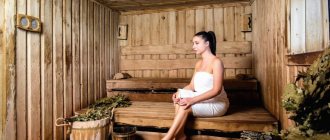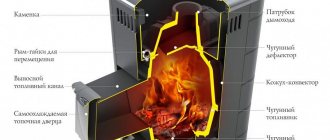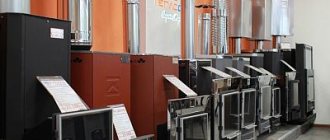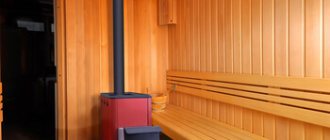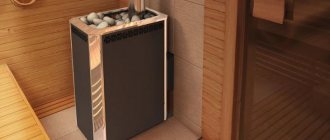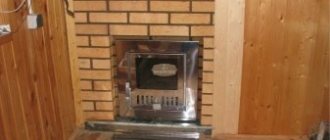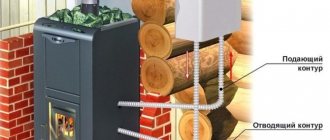Home » Reviews and Ratings
Vladimir 08/09/2021
3952 Views
Bath procedures not only charge us with energy for the days ahead, but are also responsible for the health function, helping to prevent various diseases. The main aspect that influences the pleasure of this process is the sauna stove. With its help, you can create a suitable microclimate with light steam, taking into account temperature and humidity, allowing you to create the most comfortable conditions for everyone. Each sauna stove model has its own power, dimensions, specific type of fuel and technical characteristics. To understand which stove is best for a Russian bath, you need to take into account many parameters.
Criteria for choosing a stove for a bath
The basic indicator is power. It is impossible to indicate universal numbers, but for a good model the coefficient should be optimal (8-10 kW) in order to heat the steam room and adjacent rooms.
At low power, the stove operates under wear and tear; it takes a long time to heat, wasting energy. A high rate will lead to imbalance and overheated air.
Other factors to consider:
- type, shape of structure;
- material;
- type of fuel used;
- steam source;
- principle of operation;
- type of heater.
Power is the main criterion for choosing a stove for a bath.
If a factory model is selected, it is desirable that the package includes a water container and a convector.
It is recommended to read consumer reviews, instructions, and check the product for compliance with GOST.
Preparation of the solution
It is not recommended to use cement mortar for masonry. It is not heat-resistant and does not tolerate temperature changes well. Experts recommend starting a mixture based on clay and sand.
There are no exact proportions for the composition. Focus on consistency.
- Clay is used red or fireclay. No large inclusions.
- The material is filled with water and left for 24 hours. After this, knead until soft. The clay should stick slightly to your hands.
- After this, sand is introduced, previously sifted through a sieve.
- The composition is mixed until homogeneous.
The readiness of the solution is determined by dipping a stick into it and shaking it. If the remaining layer exceeds 3 millimeters, then sand is introduced. If less than 2 – clay. The optimal layer is 2 millimeters.
Calculation of stove power for a bath
Average value: 1 kW = 1 cubic meter. The technique is as follows:
- Calculate the volume of the steam room. If the room is 3x2 m, the ceiling height is 2.3 m, then the figure is 13.8 cubic meters.
- Calculate the area of window and door openings, multiply the resulting figure by 1.2 to calculate heat loss. Sum up the areas. If the window is 0.4 sq.m. and the door is 1.8 sq.m., then the total area is 2.2 sq.m.
- Find out the volume. Taking into account the indicated values - 2.2x1.2 = 2.64 cubic meters.
- Add up the indicators. Result - 16.44 cubic meters.
If the bathhouse is unfinished and the thermal insulation is low, then the resulting figure should be multiplied by 1.6 (16.44x1.6 = 26.3). The desired value is 26-30 kW (if taken with a small margin).
As standard for factory units, the power is specified in the accompanying documentation. If it is missing, then the area of the space is taken into account for the calculation. The volume of the firebox is calculated and multiplied by 0.5.
Building regulations
Installation of the external chimney is carried out in accordance with the requirements set out in SNiP 2.04.05 - 91 and DN V.2.5-20-2001. Namely:
- the height of the passage through the pipe wall should be within 1 - 1.5 m from ground level;
- the minimum height of the structure is 5 meters;
- the smoke exhaust duct cannot have more than 3 turns with a radius of curvature not less than the internal diameter of the structure;
- the vertical part of the chimney must be located at a distance of at least 1.5 m from the edge of the roof overhang of the building and at least 1.5 - 3 m from the residential building;
- the total length of horizontal or inclined links should be no more than 1 m. Otherwise, there is a danger of more intensive fouling of the walls of these areas with products of incomplete combustion of fuel, which will impede the movement of smoke;
- elevation above the roof should be done:
- up to 50 cm if the roof is flat;
- up to 50 cm above the parapet or roof ridge, if the chimney is located closer to them than 1.5 m;
- not less than the axis of the parapet or ridge, if the pipe is 1.5 - 3 m away from them.
- The design of the smoke channel must include pockets 25 cm deep, used for cleaning combustion products.
Sauna stove material
The service life of the product depends entirely on the thickness of the heater and the material. If previously they were made only of brick, now they also use chrome steel (to produce clean indoor air, without burning oxygen) or cast iron.
Steel furnaces
Factory heaters have advantages. Products:
- lightweight, durable;
- compact;
- do not require foundation construction;
- quickly warm up the room;
- easy to install.
Steel stoves are lightweight and durable.
The disadvantage is that the fire safety level is low. The fire in the firebox must be maintained constantly, otherwise the room will quickly cool down due to the small heat capacity of the metal. The power may not be enough to heat large areas.
The best models are offered by Finnish ]Helo[/anchor], Harvia.
Cast iron stoves
Previously, users installed primitive potbelly stoves, although they are inferior to modern analogues in terms of safety and functionality. Manufacturers are now delivering safer, more durable units with increased heat transfer and heat capacity.
However, the devices have disadvantages, which include high price, fragility (cast iron can crack under loads and transportation) and dimensions, weight (a reliable foundation must be built before laying the stove).
Brick oven
They are fireproof and heat retaining. This is an option if you want to arrange a steam room like in a Russian bath. Although such heavy heaters are becoming a thing of the past, since the weight reaches 1200 kg, it is difficult to build and find a skilled stove maker.
The brick oven is fireproof.
In Rus', high-quality stone masonry for a sauna stove was considered art. These fireplaces retain heat for a long time, but are cumbersome when lighting and are oversized. They occupy most of the steam room and need to create a solid foundation.
Construction technology
Construction of a furnace is not a quick process. The work takes on average at least 1 month. The period directly depends on the qualifications of the specialist and the speed of installation. Most of the time is spent preparing the foundation and hardening it.
The main stages of work are:
- Preparation and pouring of the foundation;
- Preparation of tools and solution;
- Construction of the masonry of the main part of the furnace;
- Construction of a chimney;
- Finishing work.
All stages are carried out sequentially, observing the time limits for hardening of the solution.
Other oven selection options
When purchasing a design, take into account:
- Duration of operation of the unit. The device retains heat for a long time and operates for 3.5-4 hours without additional ignition.
- Heat storage capacity. The norm is 100 g of water per 1 cubic meter, so that the air from the steam room does not come out damp, heavy, and transparent. The temperature should not fall below 100˚C.
- The presence of a heat exchanger, thanks to which a high temperature is maintained in the bathhouse, saving on firewood.
- Price. Models with moderate power cost from 18,000 rubles.
What fuel does the stove use?
Firewood for igniting the firebox is an affordable material and even the only one if the region is not equipped with electricity or gas. The units are practical, durable and convenient. Disadvantages - the formation of ash after fuel combustion, the need to remove soot from the chimney and seal. It is characterized by a long, complex warm-up of the steam room (especially in wet weather) in contrast to other alternative options.
Firewood is an affordable material for lighting a stove.
Gas is used from mains or bottled gas. The installations are weighty, large, and difficult to install, so you can’t do it without a specialist. One of the advantages is that there is no need to constantly add firewood, keep the flame under control, or clean the ash pit. When operating gas appliances, it is enough to change the intensity of the fuel supply to keep the indoor temperature under control.
Disadvantages include a high fire hazard and replacement of containers when using bottled gas.
To connect the unit to the gas pipeline, you cannot do without the involvement of a professional.
Electric models do not have chimneys, and the appliances do not emit carbon monoxide. The user does not have to worry about poisoning from combustion products. However, the greater the power of the unit, the greater the energy consumption.
Electric models, despite their shortcomings, are in high demand. They are weightless, compact, fireproof, functional, and easy to operate. They heat rooms quickly and evenly and do not require a gas connection. Although the devices are not suitable for areas where electricity supply is intermittent. When connecting, it is important to ground the circuit.
Selecting a firebox type
This part is installed in 2 ways:
- Classic, without an external channel, with direct location in the steam room.
- With extension (located in the wall between the dressing room and the steam room).
The location of the firebox is possible directly in the steam room.
The first method is cheap, but has low fire safety ratings. The second option is more expensive, but more convenient. The stove is heated from the dressing room, and the firewood is laid without disturbing people steaming, and the microclimate in the steam room is not disturbed.
Steam source
The Russian stove emits light, dry steam when it reaches +85…+90°C. Although, when the air temperature is brought to high limits and the stones are heated to 500°C in order to produce finely dispersed steam, a person can get burned. To avoid this shortcoming, manufacturers began to produce alternative designs.
For example, with a steam generator, thanks to which the temperature in the steam room remains optimal even when there is oversaturation with the necessary steam.
Heater type
There are open and closed models. The first are safe models, but with high fuel consumption. They quickly warm up the air in the steam room due to the hot stones, but do not retain heat for long after the combustion of the fuel has finished. You can steam immediately after ignition, staying in the steam room as long as you like. It is advisable to install the devices when visiting the bathhouse frequently.
Closed models are also produced with a special damper to isolate the top row of stone backfill. Previously, units with increased efficiency were installed in public steam rooms. Now - to the Russian baths for uniform heating of the room. The design independently retains heat for up to 12 hours, although it takes a long time to heat to obtain the desired temperature. You won’t be able to steam until the stones are completely warmed up. Soot quickly accumulates on them.
By type there are open and closed models.
Technical equipment of the furnace
Modern functional models include:
- Convector (air passing through the casing and screen is evenly heated, creating optimal conditions in the steam room).
- Reservoir for heating liquid. The portable container is suitable for baths with high traffic. Built-in - for a family of no more than 3-4 people (to provide plenty of hot water).
- Heat exchanger to heat other rooms, incl. locker room
Combined products are popular. Heat is delivered to adjacent rooms by moving liquid through radiators. The steam room is heated by convection.
In order for the design to be able to produce dry, light steam (not every device can), experts additionally advise buying an electric steam generator for comfort in the bathhouse.
Furnace shape
Models come in the form of a rectangle or cylinder.
The most common stoves are rectangular in shape.
Classic rectangular ovens are the best because they heat evenly.
For cylindrical analogues, the lower and upper walls can become very hot or remain cold.
Traction force
Insufficient draft force may be due to improper design, non-tight connection of parts, small diameter of the chimney, large accumulation of soot and ash inside the duct or in the boiler, as well as poor thermal insulation of the outer sections of the structure.
To avoid having to think about how to increase draft in the chimney, you need to:
- When installing the structure, monitor the quality of the connections of the parts;
- install a grate (grid-irons), which will ensure that the ash itself pours out of the combustion chamber;
- insulate the outer part of the pipe with basalt mineral wool on an asbestos sheet;
- When firing the stove, ensure that the ash door is sufficiently open to ensure adequate air exchange in the heater.
Features of room heating
There are hot and cold ovens, taking into account the degree of heating of the walls. The room will quickly become warm if the surface of the heater heats up to +100°C. This is a good option when the bathhouse is not equipped with constant heating. Although it is difficult to monitor the temperature in the steam room. The air may overheat or remain cold.
A hot stove is suitable for a private steam room because it transfers heat well through the outer walls. But you can get burned and it is difficult to regulate the heating temperature.
The walls of a cold oven heat up to +40…+45°C (no more). Cold air enters through special channels and returns in a heated form. Such stoves are safe and convenient. They are distinguished by a stable thermal regime. Although the steam room takes a long time to warm up. This option is not suitable for quickly heating up the stove and visiting the bathhouse.
Design and principle of operation
At its core, a sauna stove-fireplace is a body made of refractory and high-strength metal, inside which heat exchange processes take place. Effective heating of the stove is ensured by a labyrinth heat exchanger inside the stove; heat flows through it, which gives off its heat to the stones located along the path to the chimney pipe. The stones become hot and heat the air.
The main advantage and characteristic feature of such a stove, compared to other stoves, is the fireplace door, which allows you to unhinderedly contemplate the combustion process, without the risk of things burning around the fireplace.
Typically, the door is made of glass-ceramic, which is translucent and resistant to high temperatures, which guarantees the integrity of the fireplace.
Wood stove selection options
When purchasing equipment, consider:
- Bath microclimate, temperature and humidity ratio. It all depends on the method and heating rate. The air will be dry, the temperature and speed will be increased if the metal furnace overheats. It is better if the surface area of the product is small.
- Steam quality. Water turns into the latter at +100°C. The optimal value for humans is +35...+40 °C, achieved with the help of stones in an open heater.
Do not overheat the stones above +400°C to obtain fine steam. Otherwise, the steam room overheats beyond its normal limits.
When purchasing equipment, consider the quality of the steam.
When choosing, take into account the heating speed of the furnace. This happens most quickly in steel structures and cast iron models with greater heat capacity and wall thickness. Brick units heat up the slowest.
An important parameter when choosing is ease of maintenance, length and quality of firewood. The latter are placed from below, from above into the firebox. However, experience comes only after handling the unit. Consumers do not always realize what they might encounter after a purchase. Therefore, it is better to buy a familiar, proven model for ease of use.
Design Features
Structurally, furnaces are divided into:
- Classic ones, in which the firebox is equipped with a solid metal or glass door. The stones are placed on top of the heater.
- Mesh. The casing is assembled from metal rods.
- With a steam generator.
The classic stove is equipped with a solid metal or glass door.
Traditional designs are simple. They consist of an ash pan, a heater, a chimney, a flue, and a firebox. Additionally, a tank may be included for heating water and placing it on the chimney for convenience. This way the gases will heat the water in the container and not escape through the pipe.
Fuel loading is carried out:
- internal, through the steam room;
- external, from adjacent rooms (dressing room).
Stone capacity
Large boulders are placed down. The smaller ones go up. It is better to place them less often in relation to each other, leaving gaps. On average, 2-3 packs of 25 kg are used for 1 square meter of steam room.
The stones come in round shapes with processed edges. This is the best choice for air circulation. If oblong boulders are used, they are stacked vertically for uniform heating.
Principle of operation
Wood burning stoves are divided into the following types:
- Prolonged heating. Stones in small quantities are heated to +350°C. The outside of the heater is lined with metal sheets to prevent burns.
- Periodic, i.e. with loading the largest number of stones into the unit, heating them with the forces of an open flame. The option is well suited for a private steam room, since there is no partition. You can add water to the stones because it will not release soot particles into the surrounding air.
Wood-burning stoves come in long-term and intermittent heating types.
Warm-up time
The units are distinguished:
- Simple ones where you need to add fuel frequently. On 1 tab the device works for 8-10 hours.
- Long burning with 2 modes. First, the stove heats up, then the temperature is maintained in it.
Manufacturer
Various manufacturers supply stoves to the market. The leaders are:
- Harvia. Finnish suppliers offer floor-standing and traditional units in designer designs (corner, wall-mounted) and different in functionality. Branded wood-burning models from Harvia operate flawlessly, are characterized by long-term operation and high quality. The fireboxes are made of high-strength steel with a thickness of 1 cm or more. The outside is covered with fire-resistant paint. They will not lose their original characteristics even after prolonged use.
- Helo (Finland). It produces stylish, economical, smoothly heating electric options, budget and premium.
- "Hephaestus." Reliable ovens without seams.
- Bonfire. High-quality, inexpensive devices in stock.
- Tylo (Sweden). Units with convenient remote control modules.
Harvia offers a wide range of ovens.
Pros and cons of choosing a wood stove
When choosing, you should take into account the design features, technical characteristics of the device and pay attention to additional options and tank volume.
To wash the whole family, you need at least 100 liters of hot water in the bathhouse.
A visit to the bathhouse should be comfortable. Therefore, it is good if the package includes a steam generator and a panoramic door, and a beautiful soapstone lining is applied to the heater or coil.
Wood stoves are purchased where electricity and gas are not available. The heater can be heated to the desired temperature while maintaining the required conditions in the steam room for a long time.
The disadvantage is that you often have to throw logs into the firebox to prevent the flame from dying out. When burned, wood produces smoke and carbon monoxide. Therefore, it is imperative to take care of installing a good exhaust chimney.
How to insulate
To insulate the external sections of the chimney through the wall, basalt wool is used. It is produced in the form of plates or split cylinders and has:
- high thermal insulation qualities;
- good vapor permeability;
- high heat resistance (withstands heating temperatures up to +100ºС);
- resistance to mold and mildew formation.
Installation of insulation begins from the inlet pipe of the furnace, gradually wrapping it around the pipe until a layer of the required thickness is formed. Then it is tightened with a crimp clamp. The insulated area is covered with a steel pipe of larger diameter. A heat-resistant sealant is used to treat joints.
When using a basalt cylinder, first a casing is installed on the chimney, and then a cylinder is lowered into it, the inner surface of which and the connecting elements (“tenon” and “groove”) are treated with sealant.
Electric oven selection parameters
The following aspects are taken into account:
- Power indicator.
- The area of the room where the device is planned to be used.
- Type of heating element (tubular, tape, combined heating element).
- Facing.
- Design.
When choosing an electric oven, power is taken into account.
Main selection criteria
The stoves operate on electricity, so the package must include a remote control, built-in. The first one is much more convenient to use.
The heater or heating element is an important element of electric heaters:
- The tube-shaped part heats up to high temperatures, but its service life is short. It is better if the heating element is made of stainless material.
- The tape element is characterized by fast heating, efficiency, and environmental friendliness. It lasts a long time, consumes little oxygen and does not dry out the air much.
- Combined (tape together with a ceramic part) is an expensive heating element device. However, it has the highest temperature characteristics and has a good rate of heating the room.
The material of the furnace is taken into account. The standard case is metal. The lining itself is made of soap magnesite and soap chlorite to improve the external properties of the unit and protect owners from ultraviolet radiation.
If you decide to choose an electric sauna stove, then you need to ask the seller for a quality certificate. The unit must comply with fire safety parameters. It’s good when the heater accumulates heat, creates a uniform background and has a beneficial effect on the human body.
Advantages of electric heaters
Advantages of the models:
- Compact, do not take up much usable space, unlike solid fuel and gas analogues.
- Easy to use (if fully automated), available for controlling temperature and moisture indicators.
- Environmentally friendly because they do not have a chimney. Dust, smoke, and ash will not fly around the room.
- They have a long service life.
- Easy to use. After installation, the user will only have to turn on the device and wait for it to heat up.
Electric heaters are compact and easy to use.
Electric heaters are equipped with sensitive automation and safety shutdown devices. There will be no problems during operation and combustion of fuel.
The models quickly warm up the steam room and create soft and uniform heat. Moreover, you can install the device in any convenient place: against the wall, in the center of the room.
Modern features
Technologies enable manufacturers to produce different types of stoves with functionality and optimal technical characteristics.
If there is a source of electricity nearby, you can install an electric heater with a timer and remote control to ensure comfortable use.
By choosing a wood-burning stove, you will retain heat even after heating once. The continuous combustion model is suitable for a sauna where many people steam during the day. Installation with gas heating is economical. The main thing is to organize a fireproof base.
Pros and cons of choosing an electric oven
If you choose an electric heater, its advantages are that:
- Can be installed anywhere in the steam room since no foundation is required. The main thing is that there is an outlet nearby.
- The air in the steam room warms up quickly.
- The level of security increases.
- The temperature and optimal mode are automatically adjusted, and it is possible to regulate the water/steam supply.
- There is no need to take care of the chimney to ensure normal draft.
The electric heater can be installed anywhere in the steam room.
For installation in a city apartment or sauna, electric portals are the most advantageous option.
Expert advice
When constructing a chimney in a bathhouse, it is important to comply with all building codes and regulations in order to ensure maximum safety when taking bathing procedures. In addition, experts advise:
- install the deflector. It increases the efficiency of the furnace;
- provide a small door at the pipe outlet for cleaning the structure;
- at the junction of the vertical and horizontal sections, it is better to install a tee, which will allow you to connect a condensate drain to the system;
- Upon completion of installation, check the system for leaks. To do this, you need to heat the unit and check for leaks.
Gas oven selection options
The units are distinguished by their high rate of room heating and efficiency. There is no need to add fuel as it burns or monitor the remaining amount.
When buying a device, take into account the power of the equipment and:
- Device dimensions. It is better to choose a small model, and with an extended remote channel for fuel.
- Gas consumption (the lower it is, the better the device works).
Additionally, take into account that there are universal devices that can operate on both gas and wood.
Design features of a gas furnace
Classic gas burner devices consist of the following components:
- housings with a gas burner inside;
- water tank;
- a pallet placed at the top (to lay stones);
- removal of combustion products;
- cobblestones;
- a thermostat and a safety element so that users can monitor the temperature in the steam room and turn off the fuel supply in case of an emergency.
Features of the furnace design.
Key recommendations for selection
The equipment must be certified (you should ask the seller). This is the first and key recommendation when choosing. You should handle the gas burner carefully - strictly follow the selection rules and safety precautions during operation.
It is recommended to find out the power, efficiency of the unit when purchasing and what is the gas consumption of each burner.
It is necessary to check the design features of the equipment taking into account the characteristics and area of the room. The safest, most versatile, and inexpensive are gas-wood stoves.
It is worth refusing to buy if the seller is trying to sell the product by offering it for next to nothing at a discount.
Requirements for installing gas sauna stoves
You can’t take risks by installing gas equipment yourself.
Important installation requirements:
- there is a distance from the stove to the nearest wall of at least 50 cm;
- installation at a fire-resistant distance in compliance with all dimensions from the openings to the gas burner (see the instructions for the unit);
- use only stainless pipes when connecting the chimney to gas equipment, extending the pipe into the pipe by at least 50%, taking into account the diameter;
- opening the door outwards;
- installation of a smoke exhaust pipe at a height of 50 cm from the burner;
- sealing the junction of the chimney with the gas system.
The sauna stove must be installed at a fire-resistant distance.
Pros and cons of choosing a gas stove for a bath
The models differ from their wood-burning counterparts because:
- deprived of an ash pit and firebox;
- compact, the devices can be installed in the tightest steam room;
- Easy to use, just set the desired mode.
The disadvantages include:
- impossibility of installation where there is no gas supply;
- low fire and explosion safety;
- difficulties and dangers during self-installation.
It is better to entrust the installation of gas equipment to professionals.
Brickwork
Brick laying is carried out according to a pre-developed plan. During work, it is important to maintain the sequence of rows and the evenness of their construction. The first row should be perfect.
The general scheme for discharging a brick sauna stove with your own hands consists of a number of steps.
- The first row sets the general direction of the walls. Must be perfectly smooth. A plumb line is made from it to check the vertical.
- The next step is to make the ash pan. Its tasks include collecting waste generated during the combustion process.
- The third and fourth rows are responsible for attaching the blower. A metal strip is used to secure it. The blower is responsible for regulating the combustion process. Open position – intense flame, closed – small flame.
- After the fifth row, steel corners for the grate are laid.
- Starting from the 6th row, a firebox is installed. Fireclay bricks are used for it. The height of the firebox is 25 centimeters, the width is just over 30. A grate is placed on top of the firebox.
- In the last rows, the firebox area expands. Refractory bricks are used for external masonry. Openings are created for secondary air supply. They are made of bricks cut with teeth.
- The laying continues with the outer brick. Doors for the firebox and a partition for the chimney are installed.
- A water tank is installed.
- At the height of the 15th row, the firebox is covered with a slab of refractory material, and stones are laid on it.
- The laying of the compartment under the stones begins. Its size depends on the number and size of stones.
- The chimney is laid out last. Fireclay bricks are used for it. The chimney gradually narrows upward. Exited through a wall or roof. The passage points through the bathhouse partitions are lined with thermal insulation. The last to be installed is a chimney protected from rain and dirt.
During operation, the solution is applied to the previous row. The brick is laid with the smooth side facing the chimney. The vertical and horizontal lines are checked after each row. The remaining solution from the side surface is cleaned every 3-4 rows. After laying out, the oven is left to dry.
Model ratings
The main purpose of heaters is to heat the bath room and create a comfortable microclimate in it. But the models may differ in shape, appearance, and characteristics. Therefore, it is worth considering the best units, selected based on ratings and customer reviews.
The best wood-burning stove for a sauna
The Vesuvius Skif 22 model is popular among consumers. From the main characteristics:
- power - 22 kW;
- unit dimensions (width, height) - 560x740 mm;
- built-in “clean glass” system, so virtually no soot settles on the heater.
Vesuvius Skif 22 is a popular stove model.
Price - from 17 thousand rubles.
A good model is “Kastor KARHU”. The outer body and door are made of steel alloy. From the characteristics:
- weight - from 30 kg;
- Sauna volume (cub.m.): 8 – 40
Kastor KARHU is a popular stove model.
The cost of equipment is from 43,000 rubles.
“Sauna stove GFS-ZK in mesh 18” is a cast iron unit. Key equipment indicators:
- The volume of the steam room is 18 m³;
- Efficiency - up to 87%;
- Recommended weight of stones: 140 kg
Hephaestus GFS-ZK in grid 18 - cast iron stove for a bath.
Price - 56 thousand rubles.
The best electric stove for a sauna
A good device is the Mini Cirrus Rock 2 CRR2-30NS-P. Among the main equipment indicators:
- weight of stones - 46 kg;
- sauna volume - 2-4 cubic meters;
- power - 3 kW;
The unit is equipped with a remote control, the price of the device is from 34 thousand rubles.
A good model, according to consumer reviews, is Harvia Vega Pro BC-165. Main characteristics:
- power - 17 kW;
- weight - 15 kg;
- dimensions - 435x640 mm.
The cost of the unit is about 50 thousand rubles.
Harvia Vega Pro BC165 is a stylish and efficient electric oven.
A reliable model is the Harvia Cilindro PC70F electric oven with a built-in remote control. The characteristics include:
- dimensions - 360x930 mm;
- power - 7 kW.
You can purchase the design from 37 thousand rubles.
Harvia Delta D36E is popular. From the characteristics:
- power 3.6 kW;
- dimensions - 340x635 mm;
- weight - 8 kg.
Harvia Delta D36 is a compact electric heater.
Price - 19 thousand rubles.
Best steel stove
The Kalita Druzhina model has positive reviews. The volume of the combustion chamber is about 40 liters. The unit is designed for bath rooms up to 16-18 cubic meters.
Advantages:
- laconic style;
- ease of use;
- light weight (can be easily moved around the territory).
However, the working surface does not allow the device to be used in a large room. The model hums when wood is actively burning.
From a pro's point of view
Cast iron wood burning units are chosen from the following: Harvia, Kastor, Hephaestus, IKI, Feringer
From a hobbyist's point of view
Users like the following cast iron bath models - “Hephaestus”, Harvia, Koster.
From the point of view of undemanding vapers
Undemanding or inexperienced steamers prefer cast iron wood-burning structures Hephaestus, Feringer, IKI From steel units - Harvia, Helo
Electric oven Harvia Vega Compact BC35 Steel, built-in remote control included
The best sauna stove with a water tank
There is no universal model. According to user surveys and calculations using a separate method, the Harvia 20 RS PRO was recognized as the best stove with a water tank. This is a compact, simple, easy-to-use model. It is no worse in build quality and features than other premium analogues.
The loading of stones inside reaches 40 kg. The unit has a built-in heat exchanger. The chimney is made as a labyrinth, which increases efficiency.
The best stove for a bath with a heat exchanger
The unit from the economy class line is “TERMOFOR VITRIVIA”. The package includes a heat exchanger.
The model is distinguished by its complete set and low price. Creates a moderate indoor climate. The water does not boil, but remains hot for a long time.
The disadvantage is that the stones heat up slowly.
Pouring the foundation
The foundation is the basis of the entire building. There are increased demands placed on him. The foundation must be strong and reliable, capable of supporting the heavy weight of the building.
The construction of the foundation is carried out according to the scheme.
- Dimensions are applied to the base. Pegs are driven into the corners, and a thread is pulled over the stakes for ease of orientation. The size of the markings corresponds to the dimensions of the oven.
- Prepare the pit. Depth – 60-70 centimeters, the lower part is additionally expanded by 10 centimeters to the sides. The shape of the pit should be trapezoidal.
- A layer of sand 5-10 centimeters thick is poured onto the bottom. Broken brick or crushed stone is poured on top. Sand is also sprinkled on top. The thickness of the puff pastry is approximately 25-30 centimeters.
- Waterproofing is laid on top of the compacted brick with sand. Traditionally, roofing felt is used.
- Formwork is installed around the perimeter of the pit. A reinforcing mesh is installed in the pit itself.
- The formwork is poured with concrete. In this case, 10-15 centimeters are left to the top. They are necessary for leveling the surface and laying the base layer of bricks.
The foundation is allowed to settle and set. This period takes from 5 to 7 days, after which the formwork is removed. The voids are filled with gravel. Roofing felt is laid on top of the foundation. It is recommended to do waterproofing in two layers for reliable protection against groundwater leakage.
Answers on questions
Owners often ask different questions, which only specialists can answer.
How to choose a stove for a bath
You should definitely study information about the product before purchasing, compare prices and choose the best brand based on owner reviews and ratings.
The main criteria when choosing a design:
- power and efficiency;
- the presence of a steam generator, convection;
- shape, location of the pipe;
- equipped with a water tank;
- materials, type of heating.
The model must comply with operating conditions and technical documentation, be reliable and durable. You need to start purchasing only after studying all the details and nuances, ratings and consumer reviews, and consulting with a specialist.
Which one is better to put in the bathhouse?
Having studied the models, it is worth concluding that it is better to install in a bathhouse a structure that will heat a large volume of the room and will be safe.
The following models with heated air volume of 25 cubic meters or more are suitable for large and small steam rooms - “Vesuvius Scythian”, “Hephaestus PB”. The units retain heat for a long time and heat the room in 0.5 hours. They are easy to operate and can withstand high thermal loads (450ºC).
Which sauna stove is better - steel or cast iron?
Everyone chooses based on preferences and situation.
Steel structures, unlike cast iron ones, do not require a high-quality foundation because they are lighter in weight. They heat up the room quickly. However, cast iron retains heat longer.
Briefly about the main thing
Many owners of baths and saunas consider it optimal to use a boiler, that is, a stove supplemented with a water tank. This combination is practical and functional; it provides not only hot water supply for any bath processes, but also helps to heat the premises.
There are several ways to position the tank, based on whether it will be built-in or external. To a large extent, the choice of boiler model is influenced by whether gas, electricity or wood will be used as fuel. The volume of the tank is selected depending on the number of users.
Ratings 0
Is it possible to install a sandwich chimney in a bathhouse with your own hands?
The use of this design allows you to prevent and protect the room from possible fires. Thanks to the insulation, the heating temperature of the pipe usually does not rise.
There is a certain sequence that accompanies proper self-assembly. Strict compliance with the rules and recommendations of the manufacturer, guaranteeing the uninterrupted operation of the chimney system.
